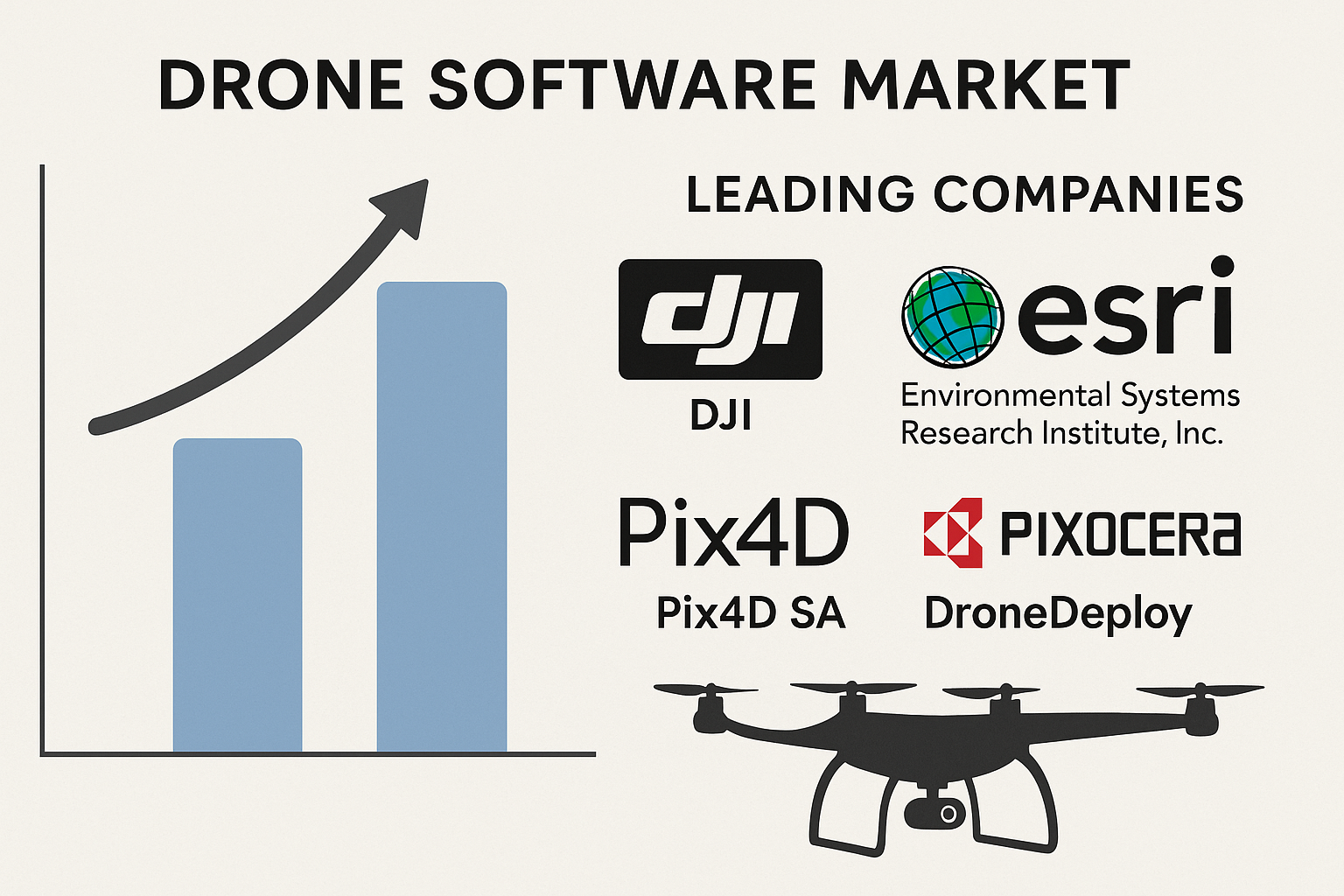The Drone Software Market size is experiencing a transformative boom, fueled by rapid advances in autonomous flight, real-time data analytics, and cross-industry integration. As drones become increasingly embedded in operations across agriculture, defense, logistics, construction, and emergency response, the role of powerful software systems is growing in both complexity and importance. From mission planning and navigation to advanced analytics and image processing, drone software now lies at the heart of modern unmanned aerial vehicle (UAV) operations.
Market Estimation & Definition
As of 2023, the global drone software market was valued at USD 5.6 billion. It is projected to reach USD 12.73 billion by 2030, reflecting a compound annual growth rate (CAGR) of approximately 17.3%. This growth trajectory signals strong investment momentum and increasing reliance on drone technologies across commercial and governmental sectors.
Drone software refers to the suite of applications and systems—both onboard and ground-based—that govern the control, functionality, data collection, and analysis capabilities of UAVs. This includes real-time navigation, flight management, image mapping, data visualization, diagnostics, and artificial intelligence integration. The market encompasses both open-source and closed-source architectures, tailored for diverse use cases and industries.
Key Growth Drivers and Emerging Opportunities
1. Broadening Applications of UAVs
Drones are no longer limited to aerial photography. They are now indispensable in sectors such as agriculture (for crop monitoring), mining (for volumetric analysis), logistics (for last-mile delivery), public safety (for surveillance and disaster relief), and infrastructure (for inspection of bridges, towers, and pipelines).
2. Integration of Artificial Intelligence
AI-powered drone software enables real-time decision-making, obstacle avoidance, automated tracking, and intelligent route planning. This drastically improves efficiency and safety, especially in complex environments.
3. Rise in Fleet and Cloud-Based Operations
Enterprises are increasingly managing large fleets of drones. Cloud-based software facilitates real-time coordination, data sharing, maintenance tracking, and centralized control—making drones scalable and secure in enterprise environments.
4. Regulatory Evolution and Compliance
Global aviation authorities are refining drone regulations, enabling safer and more organized commercial drone operations. Software helps ensure drones remain compliant with local airspace rules and flight restrictions.
5. Future Opportunities
-
Smart city applications for traffic and surveillance
-
Drones in climate monitoring and conservation
-
Autonomous package delivery systems
-
Integration with IoT and 5G networks
-
Emergency services and search-and-rescue enhancements
Segmentation Analysis
By Solution Type
-
Application Software: Includes mission planning, flight tracking, image analysis, and mapping tools. This segment holds the largest market share.
-
System Software: Covers communication protocols, middleware, and flight operating systems. Growth is expected here due to demand for autonomous and semi-autonomous drones.
By Architecture
-
Open Source: Popular in academic and research domains, favored for customization and rapid development.
-
Closed Source: Gaining traction in security-sensitive sectors like defense and critical infrastructure due to data protection and regulatory compliance.
By Deployment
-
Onboard Software: Embedded in the drone itself for real-time decision-making. Dominates the market due to autonomy trends.
-
Ground-Based Software: Controls drones remotely and processes large-scale data sets post-flight, particularly useful in industrial and survey-based operations.
By Application Area
-
Filming & Photography: Widely used in media, entertainment, and journalism.
-
Precision Agriculture: Enables crop health analysis, soil mapping, and irrigation optimization.
-
Surveying & Mapping: Essential for land management, construction planning, and mining.
-
Inspection: Used in utilities and infrastructure for routine safety checks.
-
Delivery & Logistics: Emerging as a major growth area with growing interest in autonomous delivery.
Country-Level Analysis
United States & Canada
North America holds the largest market share, thanks to strong investment in drone tech, an established commercial UAV ecosystem, and clear FAA regulations. The U.S. is also a leader in defense applications and drone fleet management systems.
Germany, UK, France
Europe’s market is driven by drone use in environmental monitoring, construction, and renewable energy sectors. Supportive regulatory frameworks and advanced R&D facilities further accelerate adoption.
China, India, Japan, Australia
Asia-Pacific is the fastest-growing regional market. China leads in drone manufacturing and innovation, while India is rapidly integrating drones in agriculture and public infrastructure. Japan and Australia focus on drone applications in disaster response and mining.
Latin America, Middle East & Africa
Emerging markets are adopting drones in agriculture, border security, and oilfield inspections. Investment in drone software is expected to grow as infrastructure and regulatory environments mature.
Competitive Landscape
DJI
A dominant force in both consumer and enterprise drone ecosystems, DJI offers proprietary software for mapping, filming, and agriculture, powering over 70% of the global drone fleet.
Skydio
Specializing in AI-driven autonomous drones, Skydio’s software is widely used in law enforcement, infrastructure inspection, and government operations.
Pix4D
Known for photogrammetry and 3D mapping software, Pix4D provides industry-specific solutions in construction, mining, and surveying.
DroneDeploy
Offers cloud-based software for real-time data visualization, flight planning, and analytics across agriculture, roofing, and logistics sectors.
PrecisionHawk, Propeller Aero, Cyberhawk
These players focus on advanced data analysis, asset inspection, and industrial drone applications.
Others
Yuneec, Parrot, and 3D Robotics contribute to the market with customized drone ecosystems, flight software, and developer-friendly platforms.
Conclusion
The global drone software market is ascending rapidly, with expectations to more than double in value over the next seven years. The intersection of AI, cloud computing, and unmanned aerial systems is reshaping how industries operate—from farming and logistics to national security and infrastructure. With strong competition and innovation in both open-source and enterprise-grade solutions, the sector is poised to play a central role in next-generation automation and intelligent aerial operations.



